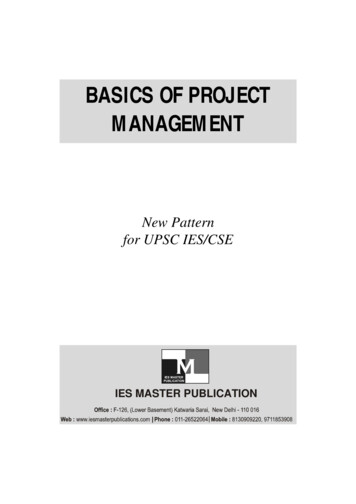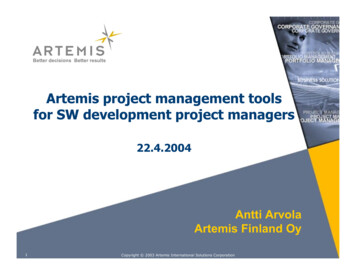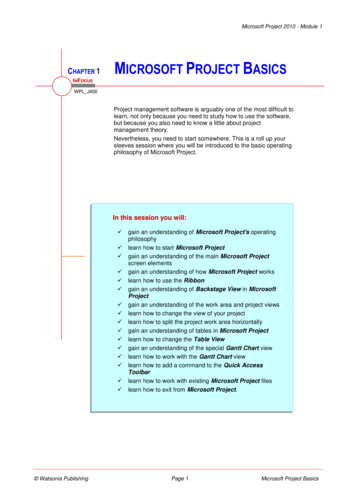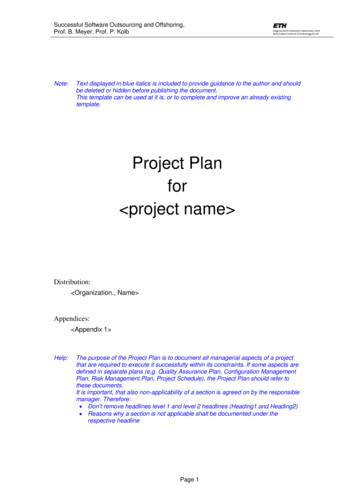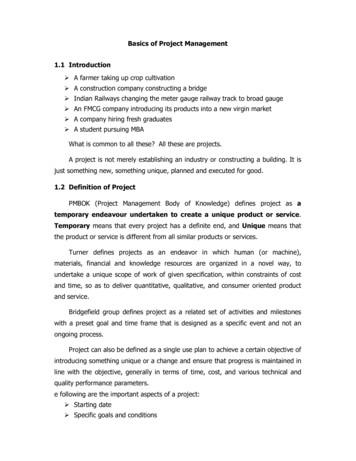
Transcription
Basics of Project Management1.1 Introduction A farmer taking up crop cultivation A construction company constructing a bridge Indian Railways changing the meter gauge railway track to broad gauge An FMCG company introducing its products into a new virgin market A company hiring fresh graduates A student pursuing MBAWhat is common to all these? All these are projects.A project is not merely establishing an industry or constructing a building. It isjust something new, something unique, planned and executed for good.1.2 Definition of ProjectPMBOK (Project Management Body of Knowledge) defines project as atemporary endeavour undertaken to create a unique product or service.Temporary means that every project has a definite end, and Unique means thatthe product or service is different from all similar products or services.Turner defines projects as an endeavor in which human (or machine),materials, financial and knowledge resources are organized in a novel way, toundertake a unique scope of work of given specification, within constraints of costand time, so as to deliver quantitative, qualitative, and consumer oriented productand service.Bridgefield group defines project as a related set of activities and milestoneswith a preset goal and time frame that is designed as a specific event and not anongoing process.Project can also be defined as a single use plan to achieve a certain objective ofintroducing something unique or a change and ensure that progress is maintained inline with the objective, generally in terms of time, cost, and various technical andquality performance parameters.e following are the important aspects of a project: Starting date Specific goals and conditions
Defined responsibilities Budget Planning Fixed end date Parties involvedProject ManagementProject management is a methodical approach to planning and guiding projectprocesses from start to finish. It is the method of planning the plan. It starts fromproject definitions and ends with goal achievement.PMBOK defines project management as the application of knowledge, skill, tooland techniques to project activities in order to meet stakeholder’s needs andexpectations from a project.Bridge group defines it as the methods and disciplines used to define goals,plan and monitor tasks and resources, identify and resolve issues, and control costsand budgets for a specific project.1.3 Project CharacteristicsThe various characteristics of the project are Fixed set of objectives: The project starts when the objective(s) isfinalized. The project comes to an end as soon as the objectives are attained. Tenure: Project is never a continuous activity, it has to come to an end. Itslife span is fixed. Team work: It needs a team to accomplish various activities. Unique: All projects are unique in themselves, no two projects are exactlysimilar. Life cycle: Like all living organisms, project starts slowly (definition phase),then starts building up in size (planning phase), then reaches peak(implementation phase) before finally getting terminated. Made to order: The customer always decides the objective and informs theconstraints like time and cost. Single entity: Generally, projects are the responsibilities of a singleperson/entity but certainly there are many participants in a project, who arehelping the single entity in the accomplishment of project objectives.
Multi-skilled staff: The staff needed for a project, including the projectmanager needs to have a wide range of skills including technical skills, humanskills, financial skills, negotiation skills, etc. Subcontracting: Subcontracting is practically unavoidable in projectmanagement. As specialized knowledge or workforce is needed for a verysmall duration in a project, it is difficult and costly to employ or retain.Therefore, they are just hired for small duration or specific job from outsideagency. Risk and uncertainty: Projects are risky as the activities involved inprojects are non-retrievable. Thus, risk is unavoidable. However, risk can bereduced considerably using various forecasting techniques and projectmanagement and control tools.1ProjectInitiationPostImplementation Review4ProjectClose and cutionFigure 1.1: A schematic diagram of project life cycle
1.4 Objectives of Project managementThere are four major objectives of project management Scope: Scope means what are the expectations from you as a projectmanager and your team. A civil contractor always has well-defined scope, likeall civil works including excavation, foundation, concreting, brickwork,plastering of all walls as per the attached drawings. Performance: A project is always expected to have a well definedperformance level. If a project is unable to adhere to the desired performanceof a customer, it is certainly an unsuccessful project. Time: A successful project is the one which is completed within the timelimits perceived during the planning. As the cost is dependent on time, timemanagement becomes a crucial activity of project management. Cost: It is dependent on all the above objectives. Mathematically it can bewritten as: Cost f (P, T, S).Therefore, cost is a function of performance, time and scope. If any of theabove increases, it is surely going to increase the cost of the project.Another approach in defining the objectives is the SMART approach. Specific: Project should target a specific goal Measurable: It should be quantifiable Attainable: It should be attainable with resources available Realistic: It should be realistic in nature Time Limit: There should be fixed time limits1.5 Importance of Project ManagementWhat has led to increased usage of the concept of project management in recenttimes? Rapidly changing technologies: Technologies are changing very fast, soall manufacturing as well as service organizations have to cope up withtechnological changes, which provide a big scope for project management. High entropy of the system: Changes are very fast. So, energy levels arehigh. To adapt to the fast changing world, no organization can stick to oldthings or systems. Any modification or modernization leads to the need ofproject.
Squeezed life cycle of products: Product life cycle is squeezed to a greatextent with innovations taking place at a very rapid rate. Projects are neededfor the upgradation of products. Globalization impact: All producers and service providers in the presentworld are exposed globally. They need to modify their system of operations tomatch the global practices, thus creating opportunity for projects. Large organizations: They face problems of management of hugeworkforce and work division, so they divide their work in projects and create ateam to accomplish the objectives in the form of projects. This has alsohelped the organization to develop a method for performance appraisal. Customer focus: Increased customer focus has been a market trend inrecent times. A few years back, cost reduction was a major formula ofsuccess for an enterprise. Thus, there was more emphasis on standardization.In recent years, customer focus has redirected market towards customization.Though it is not purely customization, it is more of a combination ofstandardization and customization. All this has led to the application of projectmanagement.
Project Life Cycle and its Classification2.1. Project life cycle and its phasesProject life cycle divides the sequence of operations of project in to differentphases. Regardless of scope or complexity, any project goes through a series ofstages during its life. Project activities must be grouped into phases to facilitateproject manager and his team to plan and organize various inputs effectively. It alsohelps in identifying deviations and thus helps in decision making with regard tocontinuation or termination of the project.Generally, there are four stages of project life cycle which are2.1.1. Idea Generation (Concept Phase)Anyone who is planning to invest starts searching everywhere for new ideas.One can start a new project by defining its objectives, scope, purpose anddeliverables to be produced. He will also hire his project team, set up the projectoffice and review the project, to gain approval to begin the next phase. The basicprocesses of this initiation phase are Project document: This is a statement describing the characteristics of theproject undertaken. Project feasibility document: This contains constraints and alternativesolutions. The four steps in the project feasibility study are: Problem description Approach to be used Alternate generations for solving the problem Preliminary recommendations Project concept document: It will answer the following questions What is to be done? How will it be done? Why is it to be done? Project charter: Project charter formally communicates the initiation of theproject. It consists of project scope, project authority and KSF (Key SuccessFactors).
During this phase, project team is responsible for the following activities: Conducting interviews with customers and stakeholders Conducting research for generating more necessary information. Preparing project feasibility document, project concept statement and projectcharter.2.1.2. Project Planning PhaseProject planning phase follows the project initiation phase. Countless hoursduring the succeeding phases can be saved with proper planning.The purpose of the project planning phase is to: Determine project requirements Decide project cost and schedules Search for sources of all resourcesThe basic processes of the project planning phase are: Defining the scope: Define the scope of the project and its limitations. Preparing the work breakdown structure: Divide the whole project intosmaller activities Role assignment: Assign jobs to individuals or group of individuals aspredefined activities or tasks. Project scheduling: Determine optimum schedule of the project and showit on a Gantt Chart. Fund allocation: Allocation of funds for individual activitiesOther subsidiary processes in the planning stage are: Risk management planning: It includes identification of possible causesand effect of the risks and trying to reduce the impact of risk. Procurement planning: Decisions regarding all products, services orresources needed to accomplish the project.In the planning stage, various steps are taken which includes: Final techno-economic feasibility of the project: This is the last chancefor changing the decision, as after this stage, it proves too closely to shutdown the project or change the project. Basic engineering and process design: The process is selected and basicengineering is done. The documents with respect to equipment specificationare prepared.
Division of work/responsibilities: Different activities are allocated toindividuals or groups. Identify potential vendors and subcontractors: No project is completewithout the help of outside expert agencies called subcontractors. Thepotential suppliers of various equipment, civil construction agencies andsimilar agencies are identified and negotiated. Detailed engineering design: based on the designs of equipment supplier,detailed engineering is performed. The final layout is prepared and the workschedule prepared. Final estimation of the cost of the project: The above steps leads tofinalizing quite accurate cost of the project. This is essential as the next stepwould involve arrangement of funds. Decision of capital structure and means of finance: The final decisionwith respect to financing the project is needed during the planning phase. Itis a crucial decision generally taken by core strategic group with the advice offinance managers. Final schedule of implementation (next phase): The next phase will beimplementation. A proper schedule of implementation is essential to avoidconfusions. The schedule of implementation tells all the members of the teamwhen a particular activity should start and end. It will provide the milestonesof every activity. The techniques used are PERT, CPM, Gantt chart, crashingresource allocation and resource leveling.2.1.3. Implementation or Execution PhaseProject execution is characterized by the actual work on the tasks planned andproject control involves the comparison of the actual performance with the plannedperformance and taking appropriate corrective action to get the desired output.During this phase, project team is responsible for the following activities: The team members perform the tasks allocated in the earlier phase under thesupervision of the project manager and report to him. Project manager is responsible for performance measurement, which includesfinding variances with respect to cost, schedule and scope. Project manager is responsible for providing project status report to all keystakeholders. He should specifically inform the deviation from the plan to thestakeholders. He should also determine the root cause for the deviations and
suggest the alternate actions to encounter the deviation caused or expected.This helps stakeholders to decide the corrective action to be taken. All project key stakeholders are responsible for the review of the variances. All project key stakeholders are responsible for taking necessary action of thevariances thus determined so as to complete the project within time and cost.The basic process of the project execution can be: Execution of the project plan Handle the changes Project controlThe subsidiary processes during project execution can be: Quality control Performance monitoring Project administration Risk monitoring and control Scope and control Schedule and cost control Management of outside agencies (subcontractors)The key activities during this phase of execution include: Award contracts to contractors, vendors, subcontractors: Finalselection of suppliers of various supplies
PMBOK defines project management as the application of knowledge, skill, tool and techniques to project activities in order to meet stakeholder’s needs and expectations from a project. Bridge group defines it as the methods and disciplines used to define goals, plan and monitor tasks and resources, identify and resolve issues, and control costs and budgets for a specific project. 1.3 Project .
